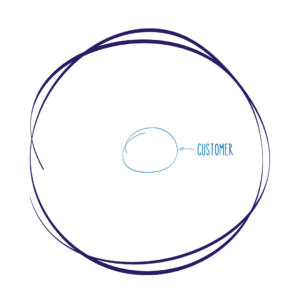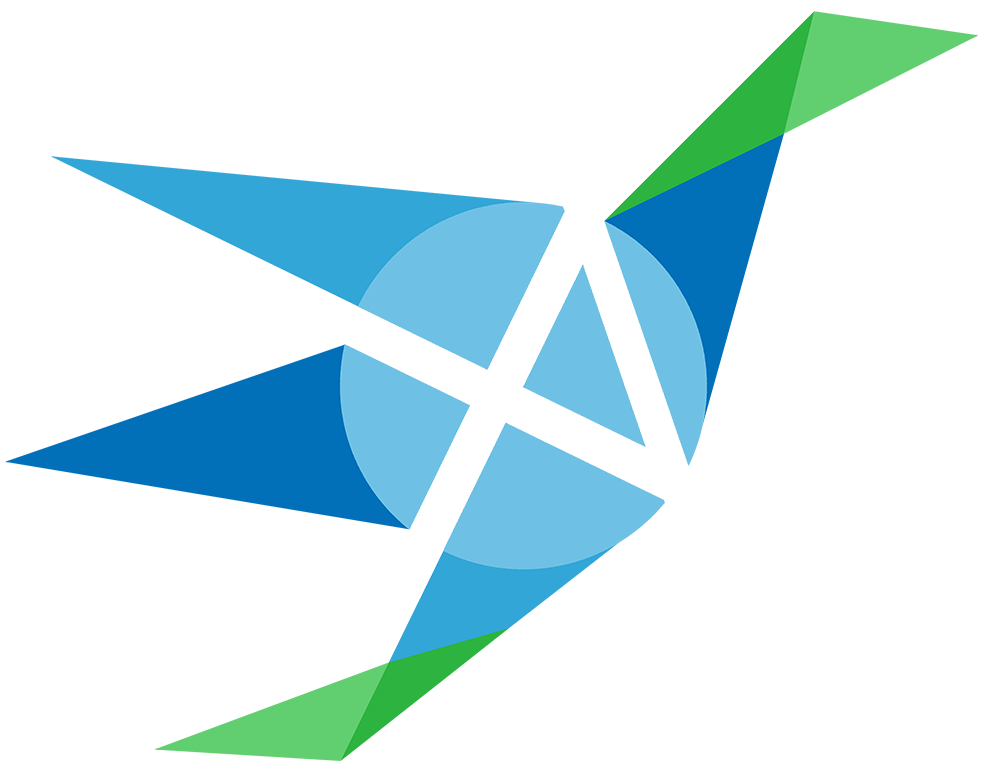“We are dedicated to becoming a customer-centric company.”
This is how the conversation started. So I asked, “What does that mean?”
The business leader proudly walked up to the whiteboard, and drew this:

And that’s the challenge. HOW exactly does a standard organization, built on the gospel of sales and customer acquisition, become customer-centric?
Short answer: It’s a marathon and not a sprint. Here’s your training guide.
5 Steps to Take To Be More Customer-Centric
1. Understand what’s known and what’s not.
WHY is this idea of “customer-centricity” so challenging?
First, most business people aren’t taught to think this way. Instead, we’re told to create business plans that include pages and pages about GETTING customers. Marketing and sales are the primary focus.
Then the plan goes completely internal. It’s all about operations, processes, and financials.
Customers – after they’re acquired – are barely mentioned. Many dashboards and reports don’t mention or track anything connected to customers. They track sales, revenue, EBITDA, and profits, among other health measurements. All of these things, obviously, are related to customer activity. But by the time employees see these reports, the results feel disconnected and sterile.
It’s understandable that our roles are defined by the internal processes and operations of our businesses. And this makes sense. But we can’t forget to continue to focus on our customers.
“Among all customers, 73% point to experience as an important factor in their purchasing decisions, behind price and product quality.” (PWC, Consumer Intelligence Series, Experience is everything: Here’s how to get it right, 2018)
So your first step is to understand WHY most people in your organization are actively trained NOT to think this way. And understand that change doesn’t happen overnight.
2. Align around purpose.
What makes a great customer experience? If you haven’t figured out what your products and services actually DO for your customers, then you need to start there.
You don’t sell widgets. You help someone succeed at their job, feel a certain way, or achieve a goal.
Disney doesn’t see their customer experience as “attend an amusement park,” and a Michelin-star restaurant doesn’t talk about “serving good food” as the best result. They talk about “creating happiness” and “making fine dining accessible and exciting.”
They understand it’s about something bigger. That sense of purpose is what allows each person on their team – from the park greeter to the sous chef to the cleaning crew – to connect their role with the bigger experience.
It creates a meaningful way to move forward on behalf of customers, not because of or in spite of them!
We call this the Customer Experience Mission Statement . This mission isn’t about the basics and doesn’t focus on products. It’s about how you show up for customers – no matter what.
3. Get real about goals.
I’ve seen plenty of goals that are really just wishes.
It’s easy to create goals in customer experience that are either:
- Based on metrics that the customer feedback team held responsible can’t influence, like NPS
- Or big ideas that aren’t real goals, like “make every customer delighted every time”
Every other team has real goals. Customer experience deserves them, too.
Some goals need to be the baby steps to get to the bigger goals. For example, if a big goal is to start collecting customer feedback at key points in the journey, then you need a tool for that. If the implementation of the technology is slow, cumbersome, or just not getting the adoption required, then it’s fruitless to create a goal about customer feedback.
Instead, a goal could be to get a percentage of adoption or a successful implementation.
Get real. Don’t take on the world!
We address this by helping teams create CX Success Statements . These are time-bound statements that connect customer experience efforts to business results. And these are the results that tie into larger organizational goals.
Nothing gets your C-Suite more excited than seeing real goals that connect with organizational success. And, having REAL dates, real ways to measure success, and real discussions about ROI makes everyone happy.
Related: Use SMIRC Goals to Define Customer Experience Outcomes
4. Think of customer feedback as collaboration.
It’s easy to get caught up in the cycle of collecting “feedback” in the form of ratings and metrics. Reporting that out to leadership and teams can feel like the bulk of the work. And it’s easy to think THAT’S being customer-centric.
We like to think of this as customer collaboration because it creates a different view of not just collecting feedback, but working with customers to create better experiences.
If you’re not collecting any feedback, of course, that’s a good place to start. But collecting is not enough. Being customer-centric means having a solid plan of learning and acting on that feedback.
I like leveraging tools like customer journey mapping, co-creation sessions, and a feedback journey strategy to connect and collaborate with customers on an ongoing (and strategic) basis.
This is also where knowing who is working on what and why is so critical. Avoid the trap of saying “customer experience is everyone’s job” because that doesn’t create real accountability. YES, everyone has a role to play, but to achieve real goals you need real accountability.
We use a CX Charter to define roles and responsibilities. This document becomes an effective tool to keep everyone aligned around the CX Mission and CX Success Statement.
5. Share, socialize, and celebrate often!
Organizations that evolve into a customer-centric organization recognize the hard work of those involved. Celebrate when customer journeys are improved. Reward great ideas and recognize the teams who deliver.
Share customer stories and socialize results in big ways.
The real “outcome” here is not a destination. Being customer-centric means bringing the customer into decisions and leveraging learning to improve faster than your competitors.
It also means doing what’s right based on what you’re trying to do for the world. And sometimes, that means slowing down to get the basics right and prioritizing in the ways that will best serve customers for the long term.
This work we do is not always straightforward. It can be messy and confusing. Becoming customer-centric requires brave leaders like you to light the path.
Sometimes a diagram helps. 🙂

 Jeannie
Jeannie